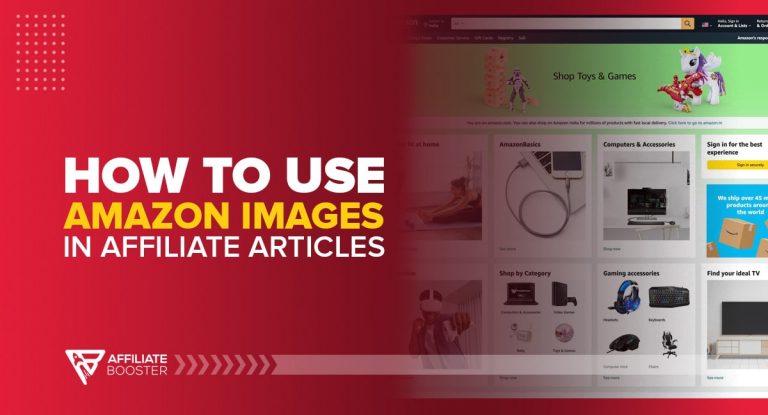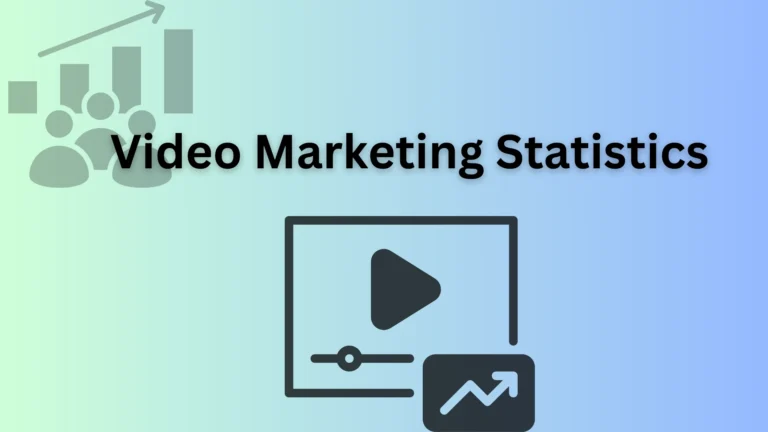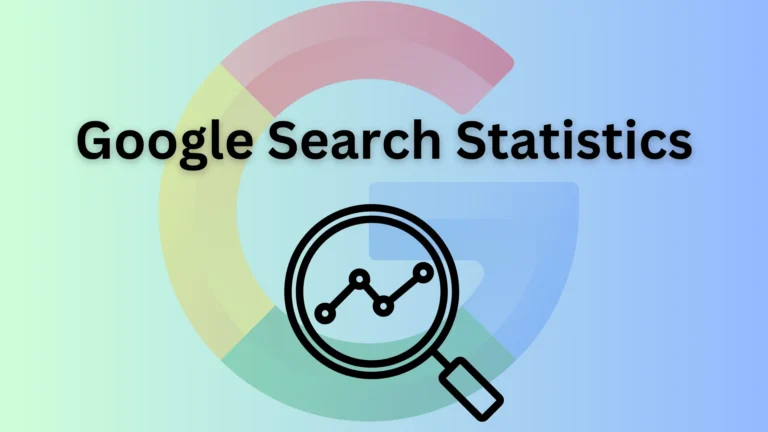A Customer Relationship Management (CRM) system is like a super-smart notebook for your business. It keeps track of your customers, who they are, what they buy, and what they like so you can sell more and keep them happy.
In 2025, CRMs are a big deal because it helps businesses, big or small, stay organized and make more money.
This guide explains the top CRM stats for 2025. I’ll break down each number, show why it matters, and give detailed ideas on how you can use it to improve your business.
I’ve added tables to make the stats clear and trustworthy. Whether you run a coffee shop, a clothing store, or an online service, these stats will help you connect with customers better.
Why CRM Statistics Are Important for You?
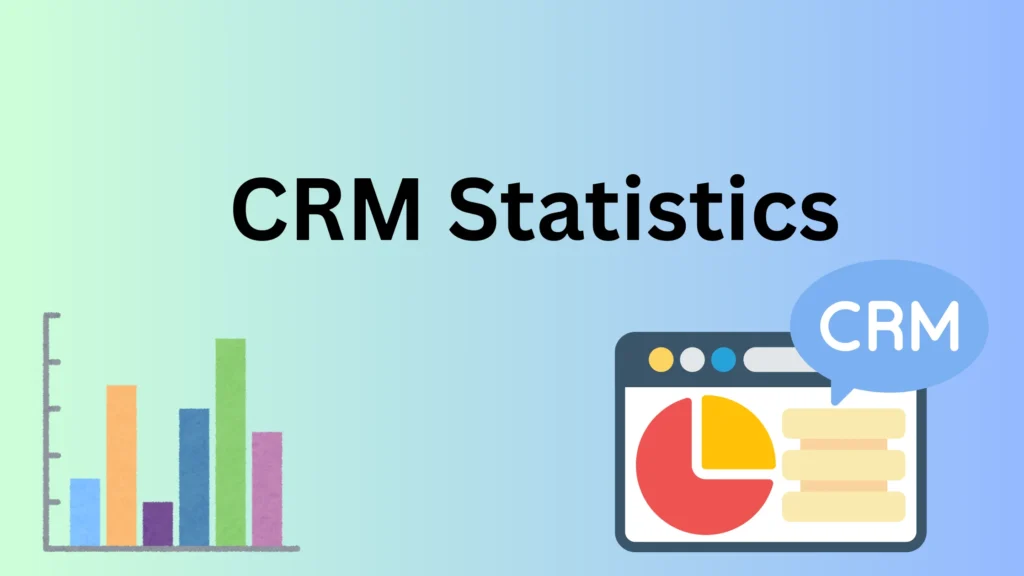
Think of these stats as a map to find your treasure of more sales and loyal customers. Here’s why they matter:
- Save time: A CRM does boring tasks like tracking orders so you can focus on big ideas.
- Know your customers: Learn what they want so you can offer the right products.
- Make more money: Happy customers buy more and tell their friends about you.
- Beat competitors: Businesses using CRM are ahead, and you can be too.
Let’s explore the stats and see how they can make your business shine!
1. CRM Market Is Growing Fast
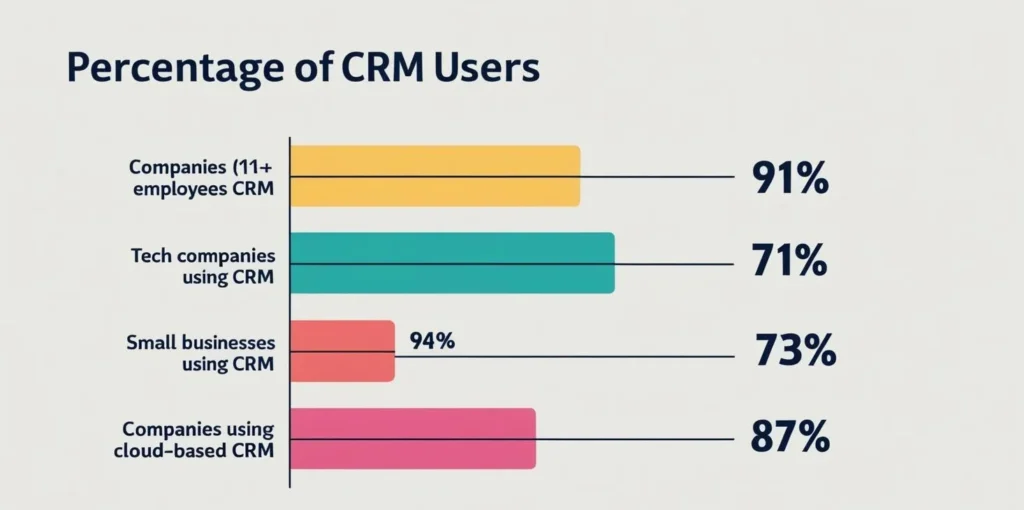
- Stat: The CRM market will be worth $97.9 billion in 2025 and grow to $131.9 billion by 2028.
- What It Means: A CRM market is all the money businesses spend on CRM tools. In 2025, it’s huge almost $100 billion! It’s growing because more companies see how CRM can help them sell better and keep customers happy.
- How It Helps You: This growth shows CRMs are popular for a reason they work! Even if you’re a small business, you can use a CRM to act like a big company. For example, if you own a bakery, a CRM can track who buys your cakes and remind you to give them a discount for their birthday. This makes customers feel special and keeps them coming back.
- Detailed Example: Imagine you sell handmade jewelry online. Without a CRM, you might forget who bought your necklaces or what they like. With a CRM, you store their names, emails, and favorite styles. When you get new earrings, you send a quick email to customers who love earrings, offering a 10% discount. More of them buy, and your sales go up all because the CRM helped you stay organized.
Table: CRM Market Growth
| Year | Market Size | Growth Rate |
| 2025 | $97.9 billion | 11.01% |
| 2028 | $131.9 billion | 10.20% |
Why Trust This? These numbers come from Statista, a trusted source that studies business trends.
2. Most Businesses Use CRM
- Stat: 91% of companies with more than 11 workers use a CRM, and 71% of small businesses do too.
- What It Means: Almost all bigger and small companies use CRM. They use it to keep customer info, track sales, and make work easier.
- How It Helps You: If so many businesses use CRM, it’s a sign they’re helpful. You don’t need a big team to start there are free CRMs like HubSpot that are perfect for small shops or startups. A CRM helps you remember every customer so you don’t lose sales by forgetting to follow up.
- Detailed Example: Let’s say you run a pet grooming service with just you and one helper. You’re busy washing dogs, so it’s hard to track who’s coming back. A CRM lets you save each customer’s name, their dog’s name, and when they last visited. If someone hasn’t booked in a while, the CRM reminds you to send a friendly text offering a discount. They book again, and you make money you might’ve missed. Even with a small team, a CRM keeps you on top of things.
Table: CRM Usage by Business Size
| Business Size | % Using CRM | How It Helps You |
| 11+ Employees | 91% | Stay organized with bigger teams |
| Small Businesses | 71% | Grow without needing lots of staff |
Why Trust This? This comes from LinkedIn and other studies asking businesses about their tools.
3. CRM Boosts Sales Big Time
- Stat: Businesses using CRM see 300% more conversions (turning visitors into buyers).
- What It Means: Conversions are when someone goes from just looking to actually buying. A CRM makes this happen three times more often by helping you talk to customers at the right time with the right offer.
- How It Helps You: A CRM is like a coach that tells you how to win customers. It tracks what people do, like visiting your website or asking questions, so you can send them deals they’ll love. This means more sales without extra work.
- Detailed Example: Picture a small gym you own. Someone signs up for a free trial but doesn’t join afterward. Without a CRM, you might forget about them. With a CRM, you see they tried a yoga class, so you email them a special offer for yoga memberships. They sign up because you reminded them at the perfect moment. That’s a sale you wouldn’t have gotten, and the CRM made it easy.
Table: CRM Sales Benefits
| Benefit | Improvement | How It Helps You |
| Conversions | 300% | Turn more visitors into buyers |
| Sales Revenue | 41% | Earn more from each customer |
Why Trust This? These stats are based on real business results from Five CRM and LinkedIn.
4. CRM Makes Customers Stay
- Stat: 47% of businesses say CRM helps keep customers longer.
- What It Means: Keeping customers is called retention. A CRM helps you make customers happy so they don’t go to competitors. Almost half of businesses see this happen after using a CRM.
- How It Helps You: Loyal customers are gold they buy again and tell others about you. A CRM reminds you to check in with customers, send thank-yous, or fix problems fast. This builds trust and keeps them around.
- Detailed Example: Suppose you sell coffee beans online. A customer buys once but doesn’t return. Your CRM notices and suggests sending a “We miss you!” email with a free sample offer. They order again and start buying monthly. CRM helps you retain that customer instead of losing them to another coffee brand. Plus, they might tell friends, bringing you even more sales.
Table: Customer Retention
| Benefit | % of Businesses | How It Helps You |
| Better Retention | 47% | Keep customers for more sales |
Why Trust This? This comes from Resco.net surveys of businesses using CRM.
5. CRM Saves Time with Automation
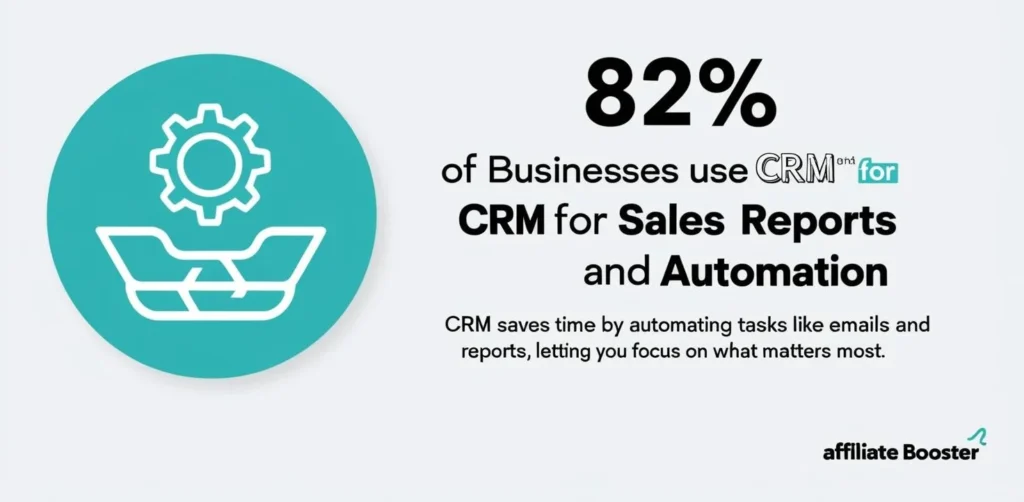
- Stat: 82% of businesses use CRM for sales reports and automation.
- What It Means: Automation is when the CRM does tasks for you, like sending emails or making reports. Most businesses use CRM to save time on these jobs.
- How It Helps You: Instead of spending hours writing emails or checking sales numbers, a CRM does it automatically. This frees you up to focus on fun stuff, like creating new products or meeting customers.
- Detailed Example: Imagine you run a tutoring service. Every week, you email parents about their kids’ progress. Doing this by hand takes hours. A CRM can send those emails automatically, using a template you set up once. It also tracks which parents reply so you know who needs a follow-up call. You save time and look professional, which makes parents trust you more.
Table: Automation Uses
| Task | % of Businesses | How It Helps You |
| Sales Reports | 82% | See sales fast and easy |
| Automation | 82% | Save hours on boring tasks |
Why Trust This? This is from Grand View Research, studying how businesses use CRMs.
6. CRM Works on Phones and Tablets
Stat: 81% of CRM users check it on multiple devices, like phones or tablets.
- What It Means: People can use their CRM anywhere, on a phone at a coffee shop or a tablet at home. This makes work flexible and fast.
- How It Helps You: You’re not stuck at a desk to manage customers. A mobile CRM lets you check sales or answer questions on the go, so you’re always ready to help customers and make sales.
- Detailed Example: Say you own a food truck. You’re parked at a festival, serving tacos, when a regular customer asks about catering their party. With a mobile CRM on your phone, you can quickly check their past orders and suggest a menu based on what they like. You send a quote right there, and they book you. Without the mobile CRM, you might’ve forgotten details or lost the sale.
Table: Mobile CRM
| Feature | % of Users | How It Helps You |
| Multi-Device Use | 81% | Work anywhere, anytime |
| Mobile Access | 48% | Use your phone to stay on top |
Why Trust This? These stats are from Forrester and Nucleus Research, tracking CRM habits.
7. Cloud CRM Is Super Popular
- Stat: 87% of businesses use cloud-based CRMs.
- What It Means: A cloud CRM lives online, not on your computer. You can access it from anywhere with internet, and it’s easy to update.
- How It Helps You: A cloud CRM is simple to use and doesn’t need fancy equipment. You can log in from home, work, or even on vacation to check on customers. Plus, it’s often cheaper because you don’t buy expensive software.
- Detailed Example: Let’s say you run a small flower shop. You’re at a wedding expo, meeting potential clients. With a cloud CRM like Pipedrive, you can add new contacts to your phone app right away. Back at the shop, you see those same contacts on your laptop and send them price lists. The cloud keeps everything in sync, so you never lose track, and you book more weddings.
Table: Cloud CRM Usage
| Type | % of Businesses | How It Helps You |
| Cloud-Based | 87% | Easy access from anywhere |
Why Trust This? This comes from SuperOffice, a CRM company studying user trends.
8. AI Makes CRM Smarter
- Stat: 61% of businesses plan to add AI to their CRM by 2028.
- What It Means: AI is like a brain that helps your CRM think. It can guess what customers want, write emails, or spot sales chances. Many businesses are excited to use it soon.
- How It Helps You: AI saves you time and makes customers happier. It can suggest the best time to call a customer or warn you if someone might stop buying. This helps you act fast and keep sales strong.
- Detailed Example: Picture a bike repair shop you own. Your CRM with AI notices that a customer, Mike, hasn’t brought his bike in for six months. It suggests sending him a tune-up discount because he usually comes every spring. You send the email, Mike books an appointment, and you make money you might’ve missed. AI did the hard part, spotting the opportunity.
Table: AI in CRM
| Feature | % of Businesses | How It Helps You |
| Planning AI Use | 61% | Smarter ideas for sales |
| Cost Savings | 41% | Spend less on routine tasks |
Why Trust This? This is from Market.us, researching AI trends in business.
9. CRM Gives Great Returns
- Stat: For every $1 spent on CRM, businesses get back $8.71.
- What It Means: This is called return on investment (ROI). Spending a little on a CRM makes you a lot more money because it helps you sell better and keep customers.
- How It Helps You: A CRM is worth the cost. Even a free or cheap CRM can boost your sales enough to pay for itself and more. It’s like planting a seed that grows into a money tree.
- Detailed Example: Suppose you run a cleaning service and spend $50 a month on a CRM like Zoho. The CRM helps you follow up with clients, so you book five extra jobs a month, earning $500. That’s $450 profit after the CRM cost a huge win! Over time, those extra jobs add up, and your business grows without you working harder.
Table: CRM ROI
| Investment | Return | How It Helps You |
| $1 | $8.71 | Make way more than you spend |
Why Trust This? This stat is from CRM Search, studying business profits.
10. Challenges to Watch Out For
- Stat: 32% of CRM users say a lack of tech skills is their biggest problem.
- What It Means: Some businesses find CRM tricky because they don’t know how to use them. Other issues include cost (31%) or moving old data into the CRM (30%).
- How It Helps You: Knowing these challenges helps you avoid them. Pick a simple CRM with free tutorials, like Streak for Gmail. Start small, and ask for help if you’re stuck many CRMs have support teams.
- Detailed Example: Imagine you sell candles and try a CRM but feel lost with all the buttons. Instead of giving up, choose a beginner-friendly CRM like Apptivo, which has videos to guide you. You spend an hour learning, then start adding customers. Soon, you’re sending sale emails that bring in new orders. By starting simple, you dodge the tech confusion and see results fast.
Table: CRM Challenges
| Challenge | % of Businesses | How to Fix It |
| Lack of Tech Skills | 32% | Use a simple CRM with guides |
| Cost | 31% | Try free or low-cost options |
Why Trust This? This comes from Fit Small Business, asking real users about problems.
How to Start Using These Stats?
Here’s a simple plan to use these CRM stats for your business:
- Pick a Free CRM: Try HubSpot or Streak to test without spending money.
- Add Customers: Enter names, emails, and notes about what they buy.
- Automate Tasks: Set up automatic emails, like “Thank you” notes after sales.
- Use Your Phone: Download the CRM app to check info anywhere.
- Learn AI Features: If your CRM has AI, use it to suggest deals or reminders.
- Ask for Help: Watch tutorials or call support if you’re stuck.
- Check Results: After a month, see if sales or customer returns are up.
Why One Should Consider CRM Statistics?
These CRM stats show that businesses in 2025 are winning with tools that organize customers and boost sales. A CRM helps you:
- Stay on top: Never forget a customer or miss a sale.
- Look professional: Automated emails and reports impress clients.
- Grow fast: More conversions and retention mean bigger profits.
- Save effort: AI and automation do the work, so you can relax more.
For example, if you run a small bookstore, a CRM tracks who loves mysteries and sends them new book alerts. They buy more, leave reviews, and bring friends. That’s the power of these stats in action.
Quicklinks:
- Must-Know Digital Marketing Statistics: (Facts & Growth)
- Semrush Statistics: Latest Facts About a Big SEO Tool🚀
- Essential Instagram Statistics Marketers Should Know
- Social Media Users: Growth and Usage Statistics
- Telegram Statistics for Community Owners
Final Thoughts
CRMs are like a best friend for your business in 2025. They help you know your customers, sell more, and save time.
The stats prove it 91% of bigger companies and 71% of small ones use CRMs, and they see huge results like 300% more sales and $8.71 back for every $1 spent.
Start with a simple CRM, use the tables to trust the numbers, and watch your business grow. You’ve got this, and a CRM will make it even easier!

